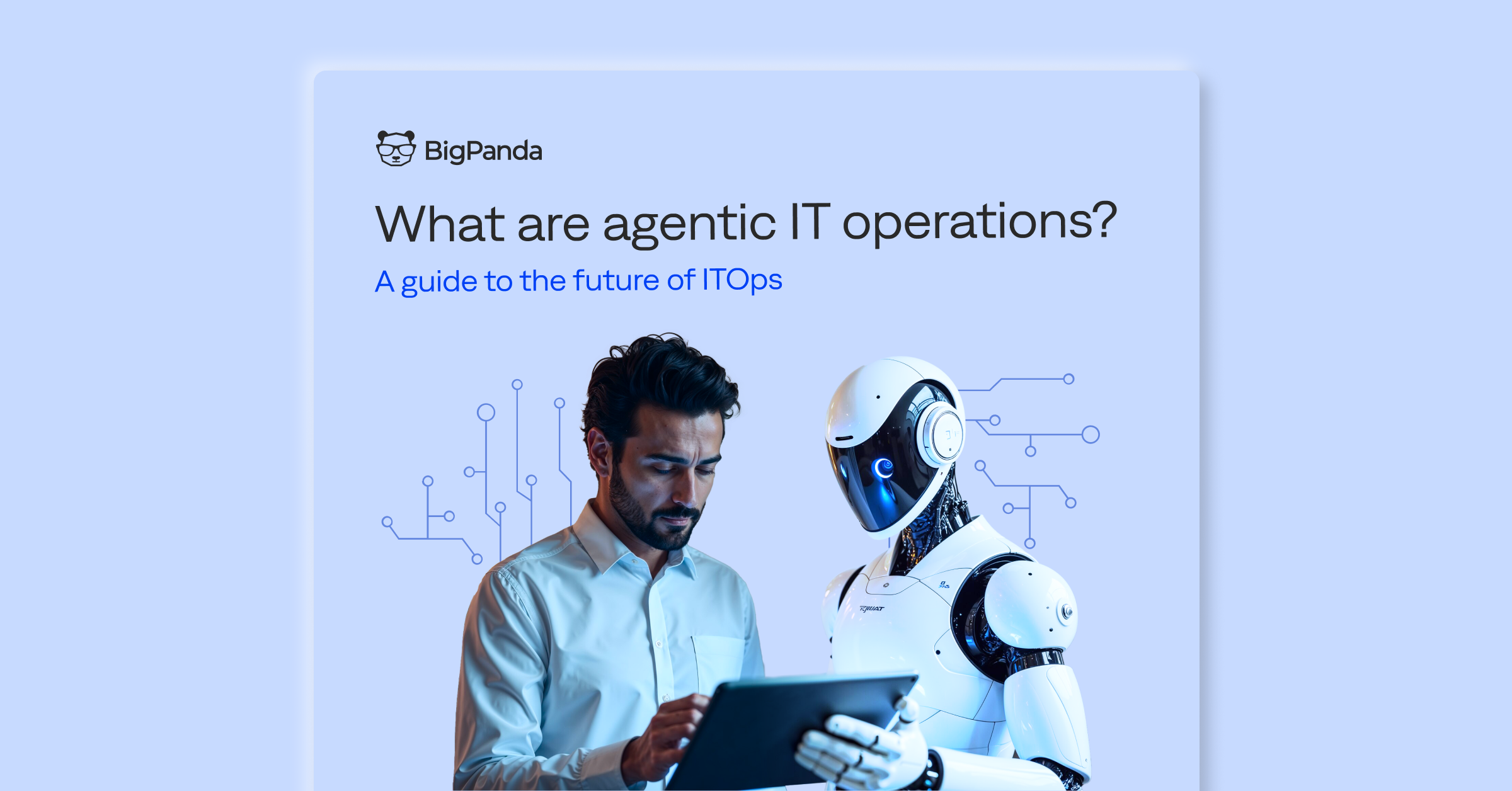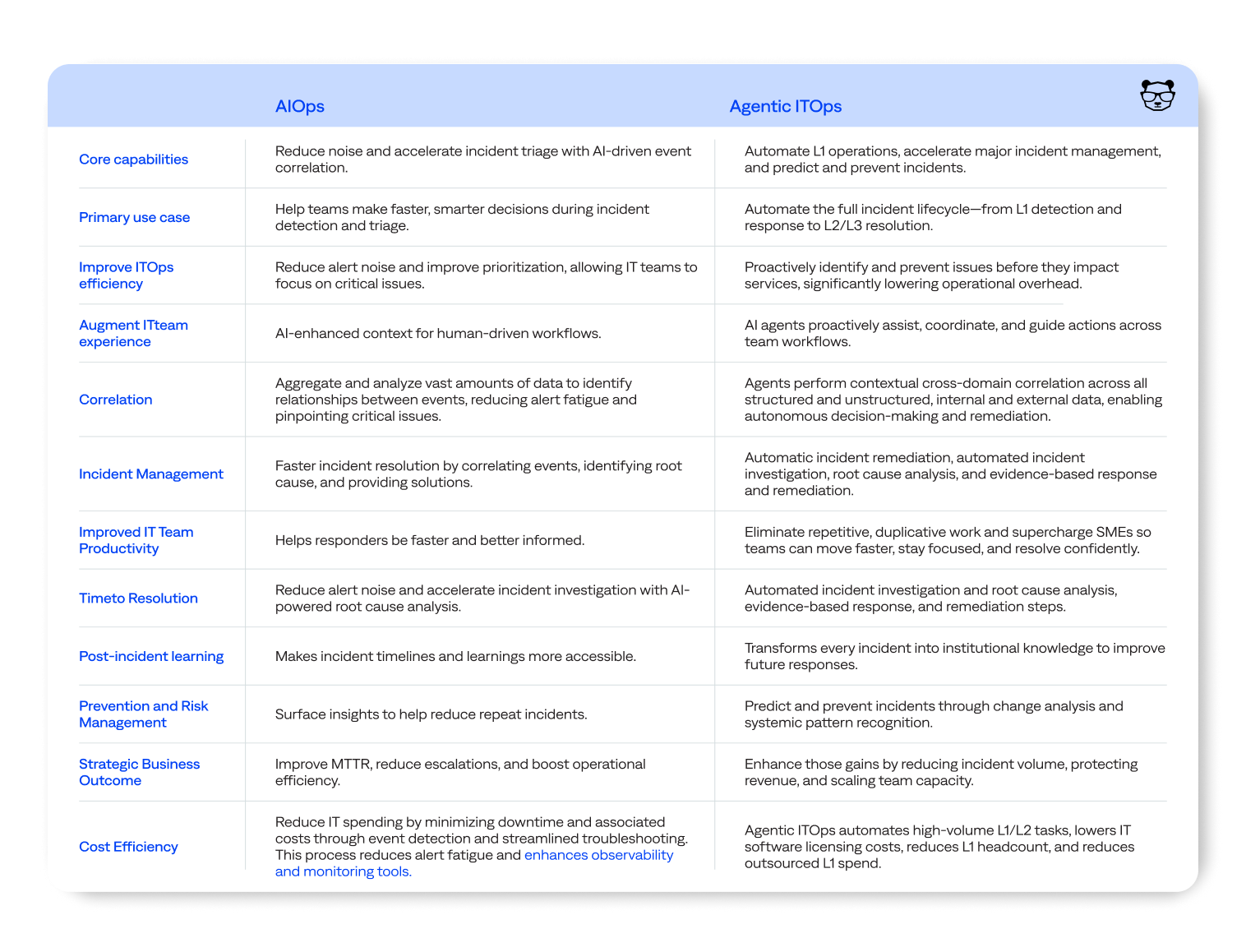Agentic ITOps: The evolution of AIOps

Enterprise IT departments are struggling to keep up with the dramatic increases in complexity, fragmentation, and chaos in their IT environments. Legacy tools and processes designed for monolithic systems and static infrastructures cannot meet these challenges. Enterprise ITOps requires a more agile and intelligent approach that leverages advances in AI and automation to remain scalable, effective, and sustainable.
For years, IT professionals have used the term AIOps to describe the incorporation of artificial intelligence into IT operations. Since Gartner coined the term AIOps in 2017, it has become almost ubiquitous, catching the imagination of practitioners, vendors, and marketing teams alike. AIOps platforms, also known as event intelligence solutions (EISs), apply artificial intelligence (AI) and machine learning (ML) to IT operations to automate, streamline, and optimize IT processes. These processes include event correlation, anomaly detection, and root-cause identification.
However, the definition of AIOps has become increasingly blurred, with associated applicability, capabilities, and use cases ever more varied. Agentic ITOps represents the evolution of AIOps by delivering on the promised capabilities of transforming manual and reactive ITOps processes into intelligent, autonomous systems. Unlike legacy AIOps, agentic ITOps can adapt to changing environments and actively collaborate with humans to detect, respond to, and prevent incidents at machine speed. With intelligent, automated workflows, enterprises can reduce operational costs and L1 spend, prevent unnecessary escalations, and improve SLAs and uptime.
What are agentic ITOps?
Agentic ITOps uses advanced AI to transform manual, reactive ITOps processes into intelligent, autonomous systems. These systems can proactively detect, diagnose, respond to, and prevent IT incidents with minimal human intervention.
Agentic ITOps significantly expands on the capabilities of legacy AIOps platforms. With agentic ITOps, enterprises gain the capabilities to automatically detect potential issues, rapidly diagnose them, assess their impact, trigger automated fixes, and even predict and prevent IT incidents before they happen.
It’s important to clarify that agentic ITOps doesn’t remove humans from the loop. It augments your responders and spares them from needless, repetitive work so they can focus on solving critical issues and supporting innovation. Advances in agentic AI mean these systems can adapt to changing environments and learn from experience, allowing them to collaborate with humans to dramatically improve the efficiency and capabilities of enterprise ITOps. With intelligent, automated workflows, enterprises can accelerate mean time to resolution (MTTR), reduce operational costs, prevent escalations, and improve SLAs and uptime.
How agentic ITOps delivers the promised value of AIOps
Agentic ITOps represents a significant advancement over legacy AIOps capabilities, incorporating autonomous decision-making and action. Advances in agentic AI can transform ITOps and IT service management (ITSM) from reactive firefighting to proactive incident management while bringing orders of magnitude improvements in efficiency and capability.
“There are $200 billion worth of manual ITOps workflows ripe for intelligent automation,” said BigPanda CEO Assaf Resnick. “With agentic ITOps, we’re helping enterprises move beyond manual, slow incident management toward intelligent systems that free up talent and reduce operating costs.”
The primary outcomes of traditional AIOps are noise reduction, correlation, accelerated root cause analysis, and improved incident workflows. While these outcomes are valuable, AIOps relies on structured data housed in a CMDB and processed through rule-based systems. This makes it challenging to keep ahead of tech stack visibility with an accurate CMDB. CMDBs also omit most of your organization’s institutional knowledge. Vital information and operational knowledge, such as team expertise, unstructured tickets, and chat logs, remain buried and unusable. This lack of information leaves your responders without the actionable context to detect, triage, and respond to IT incidents quickly and effectively.
“A CMDB was sold as an inventory and up-to-date map of the entire universe of your services and components, and it almost always falls short of that,” explained Jason Walker, Chief Innovation Officer at BigPanda. “Now you can take in information from all sources and convert it into usable data that an agentic AI assistant can incorporate into its assistance with day-to-day operations.”
Agentic ITOps significantly expands the capabilities of AIOps by eliminating the need for structured data and rules and delivering on the promise of AI-powered, proactive IT operations. Enterprises gain the ability to utilize previously untapped, unstructured data sources that can provide unprecedented understanding and visibility. Agentic ITOps uses this data to inform autonomous systems that can make decisions and perform tasks without constant human intervention. These systems, also known as AI agents, can adapt to changing environments, learn from experience, and collaborate with humans to detect, respond to, and prevent incidents at machine speed.
These AI agents can do more than analyze data. They can automatically detect potential issues, rapidly diagnose them, assess impact, prioritize accordingly, trigger automated fixes or suggest next steps, and even predict and prevent IT incidents.
By taking advantage of advances in AI and these previously untapped data sources, agentic ITOps can help enterprises:
Improve incident detection with real-time visibility into external dependencies, end-user issues, and real-world events such as power or internet outages and social media signals.
Automate L1 operations by autonomously detecting, triaging, and responding to incidents across complex and distributed environments and providing AI-driven insights and guided actions for responders.
Augment incident management teams with an AI assistant to automate workflows, accelerate resolution, and boost service reliability.
Automate IT change management with change analysis and risk mitigation, and provide clear guardrails to help teams predict and prevent change-related failures.
These capabilities save costs, reduce incidents, avoid escalations, and shift enterprises towards proactive reliability. Your teams can automatically detect potential issues, rapidly diagnose them, assess their impact, prioritize accordingly, trigger automated fixes, or suggest the next steps.
In short, agentic ITOps transforms AI from a tool to improve efficiency into an autonomous digital operator that allows your organization to shrink costs, limit risks, and accelerate growth. The following table shows the critical capability improvements that agentic ITOps offers compared to traditional AIOps.
What types of data does agentic ITOps utilize?
Critically, agentic ITOps doesn’t require highly structured data inputs to function. Rather than relying on static, highly structured configuration management databases (CMDBs), agentic AI can transform messy, scattered data into adaptive intelligence.
“We’ve reached peak frustration with getting your ITOps or ITSM teams all the fragmented, siloed CIs into a CMDB,” said Walker. “Agentic AI can ingest and index all the valuable, unstructured data from your organization and convert it into data that can be leveraged to improve your operations.”
Agentic ITOps eliminates the need for structured data and rules, opening the floodgates to various unstructured data sources that can provide unprecedented understanding and visibility. This rich, tacit data holds the keys to transforming ITOps and ITSM. Enterprises can harness a broad, differentiated dataset that unlocks vital information buried in chat histories, call transcripts, ITSM logs, and more to detect, respond to, and prevent incidents at unprecedented speed.
How enterprises can prepare for agentic ITOps
Enterprises can get started right away with agentic ITOps using their existing data. There is no need to clean your data first; agentic AI is designed to work with and handle messy, incomplete data, regardless of its state.
To help you get started, BigPanda has released our new e-book, “Laying the data foundation for agentic ITOps: A strategic guide for enterprise IT leaders.”
This guide will help enterprise IT leaders prepare their organization for agentic ITOps and lay the groundwork for advanced features, like AI Detection and Response, AI Incident Prevention, and AI Incident Assistant.
Get your copy today to learn how your organization can lay the data foundation for agentic AI-powered ITOps that improve mean time to resolution (MTTR), reduce L1 and MSP spend, prevent escalations, and improve SLAs and uptime.
To learn more about the future of agentic ITOps, we invite you to connect with our team at Gartner IOCS North America 2025. Join us in Las Vegas, NV, this December to learn how we’re leading the agentic ITOps revolution, and how intelligent, autonomous incident management can help your organization improve efficiency while reducing costs.






